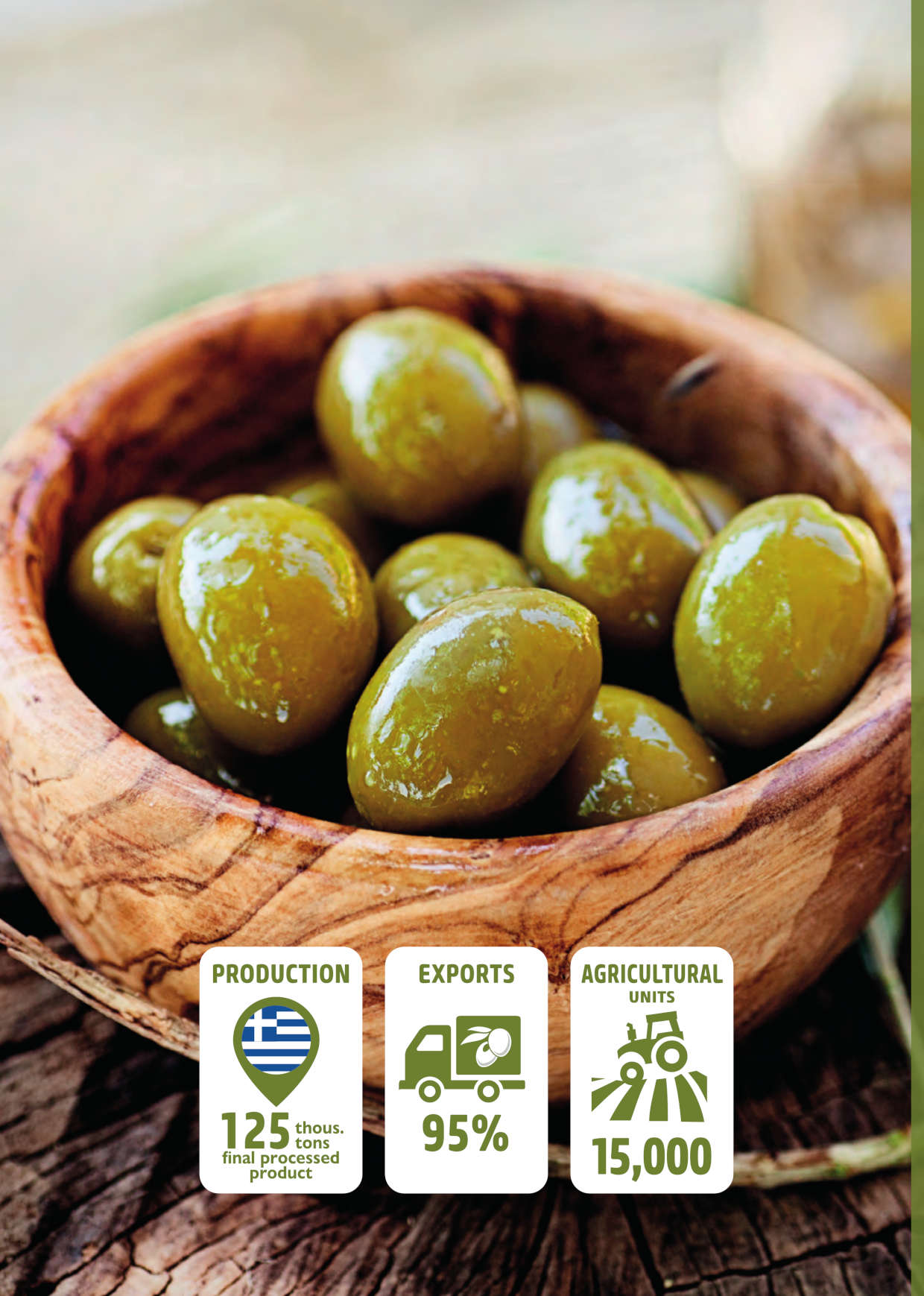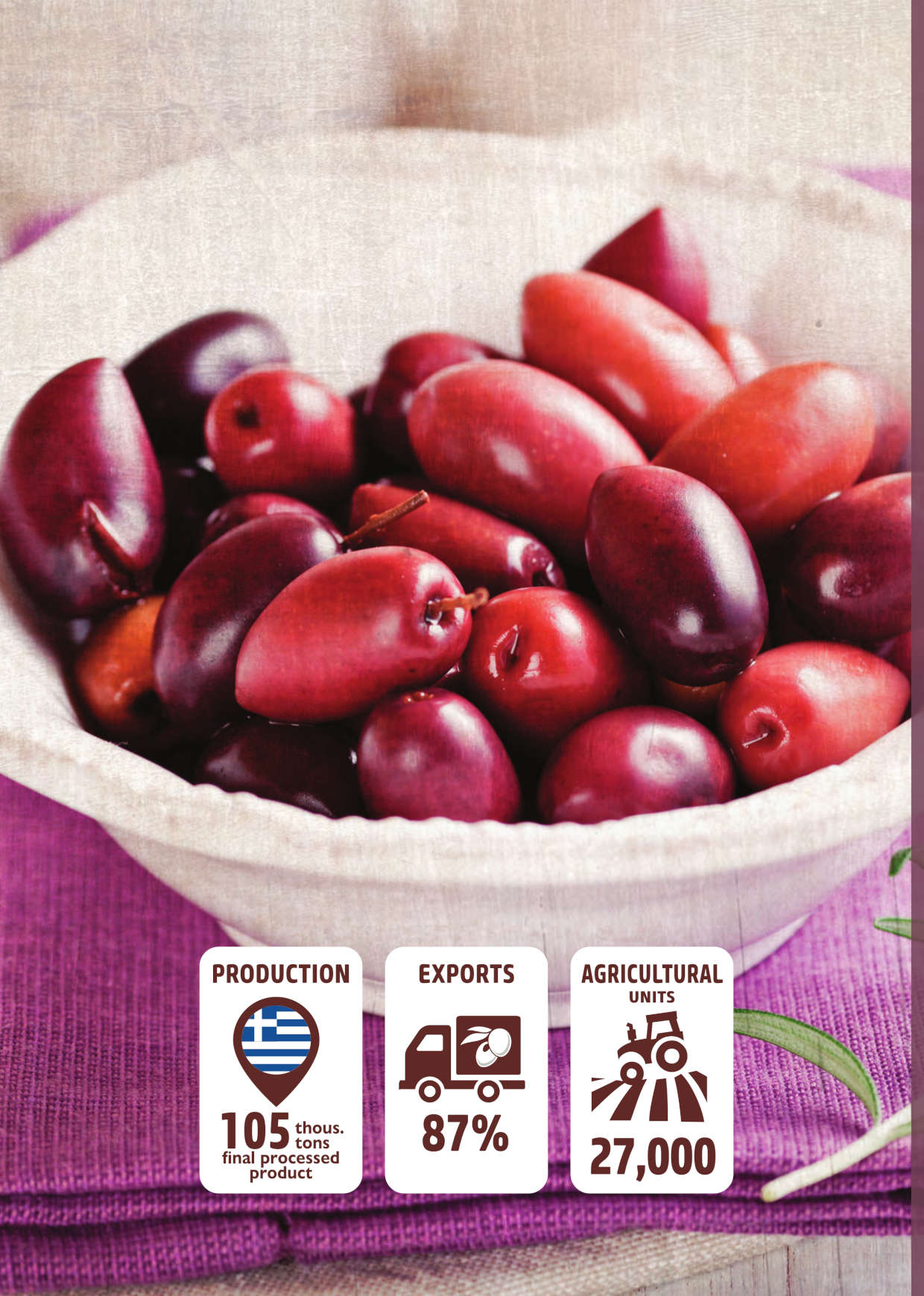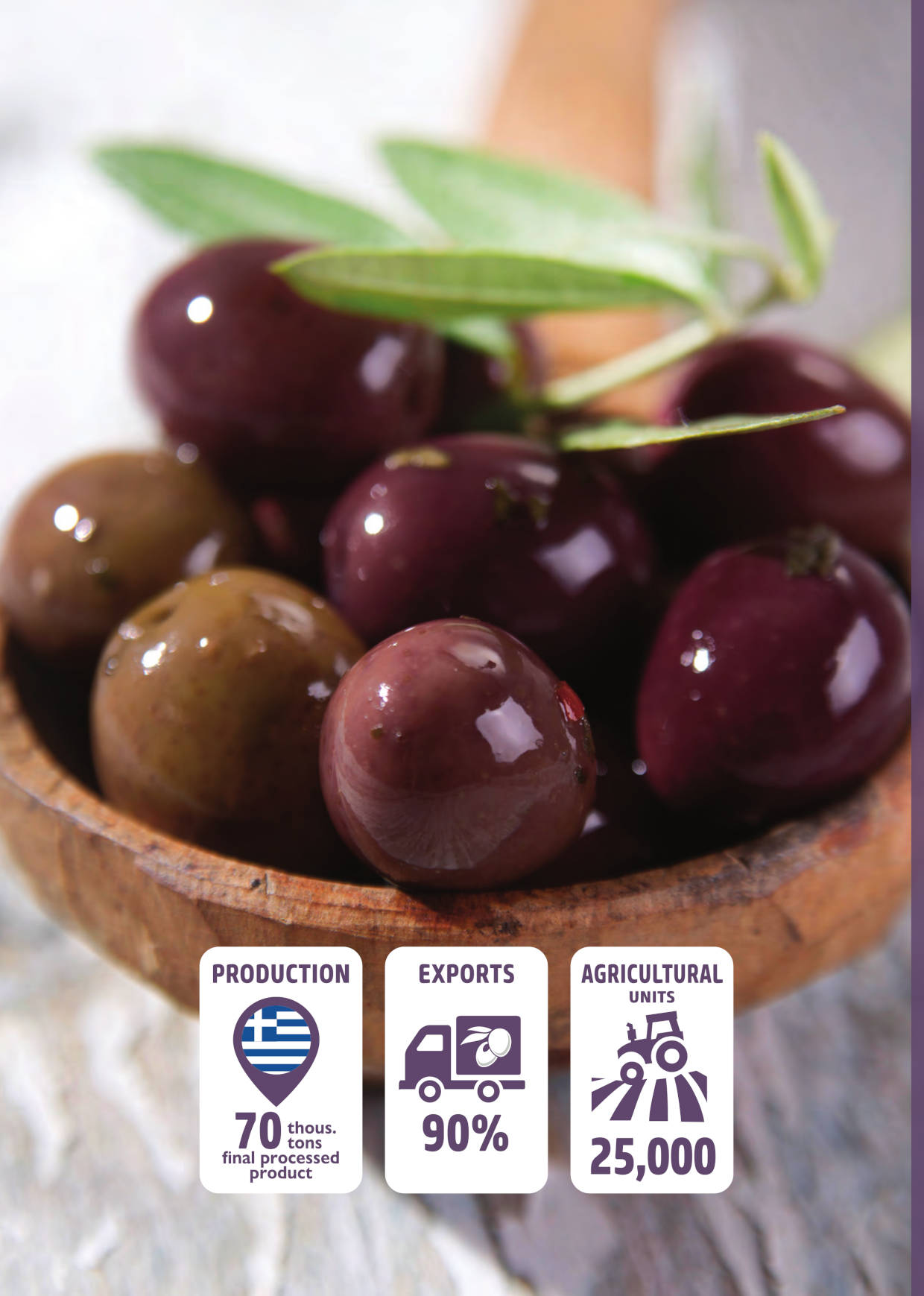
HALKIDIKI OLIVES variety
Halkidiki green table olives come from olive trees (Olea Europea sp.) of “Halkidiki” variety. Halkidiki variety olive trees are mainly grown in Halkidiki region, as well as in Central and Eastern Macedonia while to a lesser extent they are also grown in other regions of the country.
Halkidiki green olives are internationally known under the commercial name “green olives Halkidiki variety”. Their fruit is characterised by large size and cylindrical-conical shape with a pointed tip on the lower part. The bright green or greenish-yellow colour, the large flesh to pit ratio as well as the outstanding organoleptic characteristics in combination with the easy separation of the fruits’ flesh from the pit during pitting are also main characteristics of Halkidiki green olives.
Olives are collected by hand directly from the olive tree from mid-September to end-October when the olive fruits have reached the appropriate level of maturity. After harvesting, the olives are transferred to well-organised processing units in order to be processed and finally packaged. The collected olive fruits are placed in suitable tanks where they undergo curing and natural fermentation in brine, followed by a stage of maturation utilising the same brine used in previous stages, while constant expert monitoring is conducted.
Curing, fermentation and maturation processes of “green olives Halkidiki variety”could last from 2 to 6 months depending on the ripening stage of the fresh olive fruits and the ambient temperature. The final product is ready when the desirable organoleptic characteristics are acquired. The olives
are removed from the tanks and then sorted by quality and by size for commercial purposes.
After sorting (quality and size) approximately 20% of the sorted olives are transferred to packaging lines to end up as “whole olives”, while diverse commercial-“whole olive” products are available considering the differences in container size and the wide range of condiments and flavourings that could be applied. Around 70% of sorted “green olives Halkidiki variety” are pitted and are available for commercial consumption in various forms that include pitted olives, stuffed olives employing numerous fillings such as peppers, almonds, carrots, anchovies, garlic, among others, or olives with various condiments and flavourings.
Greece’s “green olives Halkidiki variety” are a major export product with high demand resulting to planting of thousands of saplings of the Halkidiki variety per year, in areas of interest.
KALAMATA OLIVES variety
Natural black table olives of the Kalamata variety (Kalamata olives) come from olive trees of the Kalamata, Aetonycholia, Hondrolia, Tsingeli, Aetonychi, Nychati or Korakolia varieties (Olea europea var.ceraticarpa) which are grown in various parts of Peloponnese and central Greece. The major producing regions in order of importance are: Etolo-Akarnania, Laconia, Fthiotida and Messinia.
Internationally these type of table olives are known with the commercial name “Kalamata olives”. The outstanding organoleptic characteristics of the final processed products, the amazing flavour as well as their dark colour and crisp flesh contribute drastically to the products’ reputation not only in national abut also in global level.
The olives are harvested by hand and/or using vibration machinery from early November to the beginning of winter when the right colour has been developed, but before full-ripening stages. After harvesting, the olives are transferred to well-organised processing plants where they undergo natural fermentation and followed by brine preservation. The excellent organoleptic characteristics of the final product are developed during maturity stages employing the same bride used for preservation characteristics under under constant scientific monitoring.
Subsequently, olives are sorted based on quality and size in different commercial size categories and can be packed either in their bulk form or after further processing (i.e. sliced or pitted olives, with pitted olives corresponding to around 60% of the final processed product). Multiple final processed Kalamata olives products are available for commercial use as besides “whole” Kalamata olives, sliced and pitted Kalamata olives can be found along with a wide range of condiments and flavourings.
This internationally recognised commercial type of Greek table olives, known as “Kalamata olives”, presents high demand along with strong exports dynamic. Thus thousands of olive saplings of the Kalamata variety are being planted yearly, mainly in Etoloakarnania, Laconia and Fthiotida regions. Over the next decade the production of this specific commercial product type it is expected to exceed 100,000 tons.
KONSERVOLIA variety
“Konservolia” is the oldest variety in Greece. The natural black table olives of this variety were first traded in the 19th century while since the early 20th century Greece’s export orientation has focused on this variety known internationally as “Greek black olives”. The Konservolia variety (Olea europaea media rotunda) is mainly cultivated in central Greece in the Fthiotida, Fokida, Magnesia, Etoloakarnania, Arta and Evia regions. It is the most widely-known olive variety in Greece and accounts for the largest number of olive trees.
Konservolia olive fruits are round to oval in shape, large in size and with a high flesh to pit ratio that can be easily separated from the pit during chewing or pitting. A key-characteristic that distinguishes Konservolia variety from others is that its olive fruit could be valorised to produce more commercial product types compared to other varieties. The most common commercial product types out of Konservolia olives are:
- Green olives in brine and
- Natural black olives in brine.
All commercial product types of “Konservolia” variety are products of natural fermentation while final products present also outstanding organoleptic characteristics. Harvesting starts in September concerning the production of green commercial product types and continuous until the beginning of winter considering natural black olives production.
Harvesting and is conducted by hand or via vibration machineries. Consequently the olives are transferred to organised processing and packaging units equiped with suitable tanks (depending on the intended commercial product type) where the fruit is cured and naturally fermented in brine.
The maturation stage that follows is conducted under constant monitoring of experts, using the brine employed in previous stages.
The duration of fermentation and maturation stages is around to :
- 2,5 to 6 months for green olives
- 3 to 9 months for natural black olives
The product is removed from the tanks after fermentation and maturation stages completion and are sorted based on quality and size.
In the case of the commercial product type “natural black olives”, final products are packed and commercially distributed under numerous product codes concerning varying size containers as well as condiments and flavourings used. The orientation of natural black olives commercial type is primarily exporting.
In the case of green olives of Konservolia variety, approximately 30% of the product is available forconsumption as “whole olives” (various packaging sizes and product codes) while around 70% of the producted is pitted and sold under various product codes which include pitted olives sold under various codes which include pitted olives and stuffed olives available in diverse size containers, with various condiments and flavourings.



